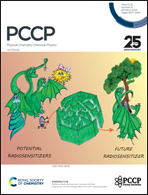Tuning the low-temperature phase behavior of aqueous ionic liquids†
Abstract
Water's anomalous behavior is often explained using a two-liquid model, where two types of water, high-density liquid (HDL) and low-density liquid (LDL), can be separated via a liquid–liquid phase transition (LLPT) at low temperature. Mixtures of water and the ionic liquid hydrazinium trifluoroacetate were suggested to also show an LLPT but with the advantage that there is no rapid ice crystallization hampering its observation. It remains controversial whether these solutions exhibit an LLPT or are instead associated with complex phase separation phenomena. We here show detailed low-temperature calorimetry and diffraction experiments on aqueous solutions containing hydrazinium trifluoroacetate and other similar ionic liquids, all at a solute mole fraction of x = 0.175. Hydrazinium trifluoroacetate, ammonium trifluoroacetate, ethylammonium trifluoroacetate and hydrazinium pentafluoropropionate all boast exothermic transitions unrelated to crystallization as well as remarkable structural changes upon cooling into the glassy state. We propose a model inspired by micelle formation and decomposition in surfactant solutions, which is complemented by MD simulations and allows rationalizing the rich phase behavior of our mixtures during cooling. The fundamental aspect of the model is the hydrophobic nature of fluorinated anions that enables aggregation, which is reversed upon cooling and culminates in the remarkable exothermic first-order transition observed at low temperature. That is, we assign the first-order transition not to an LLPT but to phase-separations similar to the ones when falling below the Krafft temperature. All other solutions merely show simple vitrification behavior. Still, they exhibit distinct differences in liquid fragility, which is decreased continuously with decreasing hydrophobicity of the anions. This might enable the systematic tuning of ionic liquids with the goal of designing aqueous solutions of specific fragility.



 Please wait while we load your content...
Please wait while we load your content...